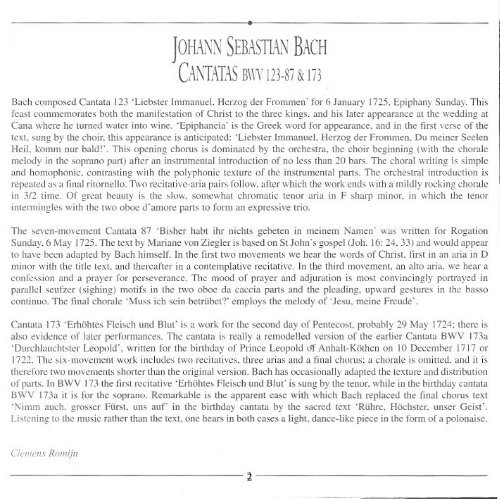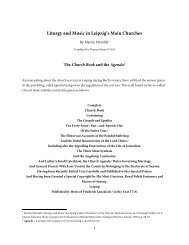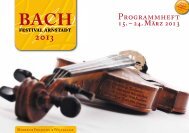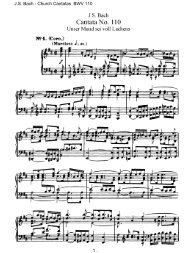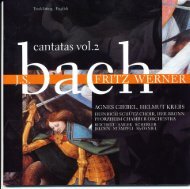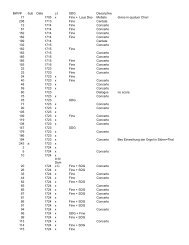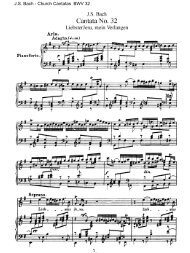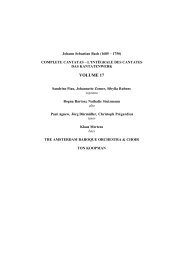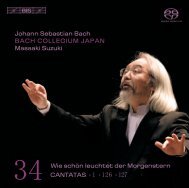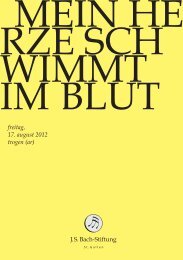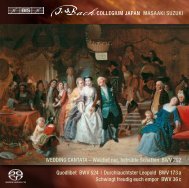Bach Cantatas, Vol. 3 - P.J. Leusink (Brilliant Classics 5-CD)
Bach Cantatas, Vol. 3 - P.J. Leusink (Brilliant Classics 5-CD)
Bach Cantatas, Vol. 3 - P.J. Leusink (Brilliant Classics 5-CD)
Create successful ePaper yourself
Turn your PDF publications into a flip-book with our unique Google optimized e-Paper software.
JOHAX~SEBASTIfL~ BACH<br />
CANTATASB\\Y 123-87& 173<br />
<strong>Bach</strong> composed Cantata 123 'Uebster Immanuel, Hcrzog der Frommen' for 6January 1725,Epiphany Sunday, This<br />
feast commcmorates both the manifestation of Christ to thethree kings, and his later appearance at the wedding at<br />
Cana where heturned watcr into wine, 'Epiphaneia' isthc Greek word for appearance,and in the first vcrse of the<br />
text. sung by theehoir, this appearaneeis anticipated: 'Uebster Immanuel. Herzog derFrommen. Du meiner Seelen<br />
Heil, komm nur bald!', This opening chorus is dominated hytheorehestm, the choir beginning (with the chorale<br />
melody in thesoprano part) after an instrumental introduction of no Icssthan 20 bars.The choral writing is simple<br />
and homophonic, contrasting with the polyphonic texture of the instrumental parts. The orehestral introduction is<br />
repeated as a tinal ritomello. Two recitative-aria pairsfollow, after which the work endswith amildly rocking ehorale<br />
in 3/2 time. Of great beauty is thesluw, somewhat chromatic tenor aria in F sharp minor. in which the tenur<br />
intenningles with thetwo oboed'amore partsto form anexpressive trio.<br />
The seven-movement Cantata87 'Bisher habt ihr niehts gebetenin meinem Namen' was written for Rogation<br />
Sunday, 6 May 1725.The text by Mariane vonZiegler is basedon St John's gospel (Joh. 16: 24. 33) andwould appear<br />
to havebeen adaptedhy <strong>Bach</strong> himself. Inthe first two movements wehear the words of Christ, first in anaria inD<br />
minor with the title texl, and thereafter in acontemplative recitative. In thethird movement, an alto aria, we heara<br />
confession and a prayer for perseverance, The mood of prayer and adjuration is most convincingly portrayed in<br />
pamllcl seufzer (sighing) motifs in thetwo oboe dacaccia partsand thepleading, upward gesturesinthe basso<br />
continuo. The final chorale 'Muss ich seinbetriibctT employs themelody of 'Jesu, meine Freude',<br />
Cantata 173'Erhohtes Fleiseh und Blut' is a work for the seeondday of Penteeost,probably 29 May 1724: there is<br />
also evidence of later performances. The cantata isreally aremodelled version of the earlier Cantata BWV l73a<br />
'Durchlauchtster Leopold', written for the birthday of Prince Leopold of Anhalt-Kothen on 10 Deeember 1717 or<br />
1722. The six-movement work includes two recitatives, three arias and afinal chorus: achorale is omitted, and it is<br />
therefore two movements shorter than the original version,<strong>Bach</strong> has oceasionally adaptedthe texture anddistribution<br />
of parts, In BWV 173the firstrecitative 'Erhohtes Fleisch und Blut' is sung by the tenor, while inthe birthday cantata<br />
BWV 173ait is for the sopmno. Remarkable is theapparent ease with whieh<strong>Bach</strong> replacedthe finalehorus text<br />
'Nimm auch. grosser Furst, uns auf' in the birthday eantata by the saered text 'Riihre, HOchster. unser Geist'.<br />
Listening tothe musie rather than thetext, one hears in both cases alight. dance-like piece in the form of apolonaise.<br />
Clemens RomUn<br />
2


